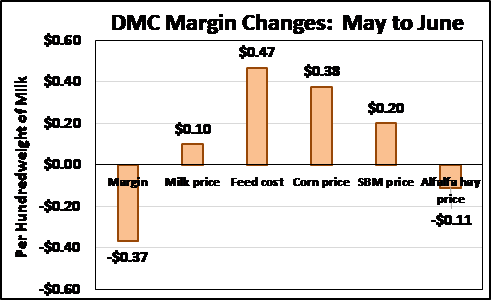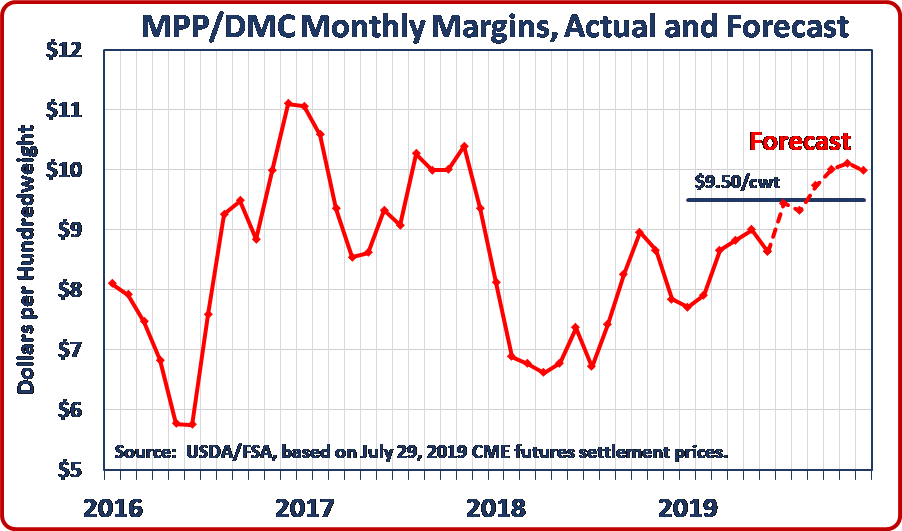Economic recoveries don’t happen overnight.
But we are starting to see enough hopeful signs to become more confident that, despite continued trade turbulence, better times may be near. While not exactly a boom, the second half of 2019 may provide producers with the best milk prices they’ve seen in half-a-decade – and with that, a chance to repair battered bottom lines while we work for policies that maintain the recovery and benefit dairy in the months and years to come.
Here’s the good news.
According to CME forecasts, dairy prices in the second half of this year may be the highest since the record-setting year of 2014. In contrast to this year’s first half, when the average milk price was $17.45 per hundredweight, second-half prices may average $19.22 per hundredweight. That’s more than $1.50 per hundredweight above any annual average since 2014, a clear improvement for producers.
Two main trends are driving higher prices: one that’s as old as dairy economics, the other one something that’s more important each year. First, dairy-product demand has been outpacing growth in supply. Increases in U.S. milk production have nearly ground to a halt after several years of expansion. Meanwhile, cheese and milk-powder demand is increasing enough to offset declines in other categories, raising the overall need for dairy products.
Second – and this is a testament to the quality of U.S. dairy and the competitiveness of its producers – exports continue to be strong by historical standards, despite severe losses in sales to China and, until recently, significant disadvantages placed upon us in Mexico, our largest market. Total U.S. dairy exports in May were valued at $539.1 million, the highest for that month in four years, thanks to rising cheese exports and world prices. U.S. dairy export volume is on track for its third-best year ever, trailing only 2018 and 2014. All this occurred despite a two-thirds drop in sales of milk powders, cheese, butterfat, whey products, and lactose to China.
To be sure, the export situation remains difficult. Overseas sales of every significant dairy product but cheese are down so far this year, and as a share of U.S. dairy production, exports thus far have fallen three full percentage points below the levels of 2018. But stronger world prices, particularly for dry milk ingredients, help strengthen domestic prices, even when exports are down. That remains good news for U.S. producers – but it also points us toward the work we need to do as markets slowly recover in the second half of this year.
It’s clear that, if U.S. dairy access to overseas markets were expanded, even more of our production could be shipped abroad, increasing the benefit to producers of greater demand for our products. We continue to press, with the White House and lawmakers in Congress, on the need to restore trade with China and aggressively pursue other markets through trade negotiations with Japan, and a greater focus on new trade agreements around the world. We need the administration to support initiatives that seek to boost U.S. dairy-market share in emerging regions and develop new markets, so that domestic producers aren’t shut out of growing global demand.
Maximization of Dairy Margin Coverage program benefits also remains important as an extra boost for farmers who will not be made whole by a recovery that’s more than a mirage, but still not a boom. It’s a positive development that more than one-quarter of all U.S. dairies have already signed up for coverage, but we will keep pushing for maximum signup before it concludes Sept. 20. With aid levels already known for the first six months of the year, joining DMC is a no-brainer – but we are available to help with decisions such as whether to lock in coverage for five years at a lower premium or go year to year, as well as explain more technical details of the program.
And, as always, we need to devote time to make sure that positive momentum in consumer demand and world markets is furthered by making sure the marketplace is fair for dairy and dairy producers. That means heading off regulations that impose burdensome business costs. It also means encouraging new rules (or at the very least, enforcement of existing ones) that ensure that milk is called milk and imposters are called something else. These initiatives can sometimes pale next to an immediate financial crisis, but they create the longer-term market conditions that help milk thrive in the years to come.
Higher prices create a rising tide for all of dairy. For all our efforts we will be the first to acknowledge that federal aid is no substitute for a vibrant market that puts more money in a farmer’s pocket. That’s why we’re working for a stronger marketplace, and for putting farmers in a better position to adapt to it and to shape it.
After five years, it will be gratifying to see distress lessen for producers. That will only make us stronger as we tackle the next set of challenges.









